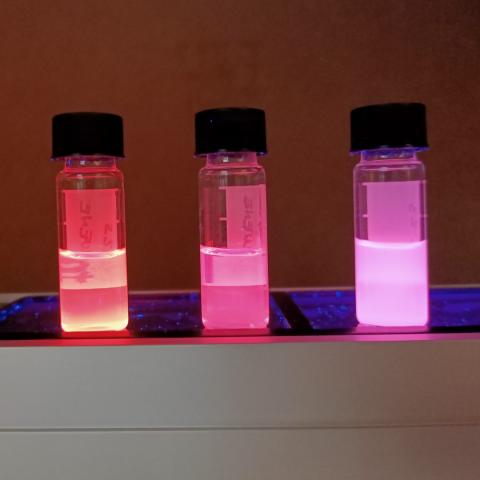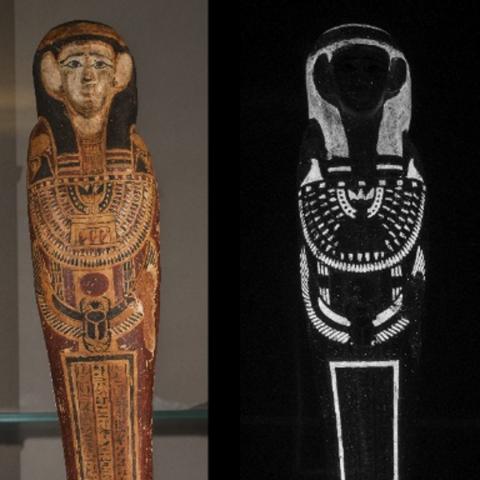Research Line
Facility & Instruments
Synthesis Lab
Our Lab is fully equipped to synthesize different inorganic materials in form of single crystals, powders, nanoparticles, and nanocrystals, and silicon-based polymers. The Lab includes muffles to perform synthesis till 1200 °C, autoclaves for hydrothermal synthesis, ovens for sol-gel synthesis, and a Schlenk line to carry out the synthesis of nanocrystals in N2/Ar atmosphere. A glove box for handling air/moisture-sensitive chemicals is also available.
Set-up for Photocatalysis
Many of the materials synthesized and characterized within our labs are tested as environmental photocatalysts, i.e., they’re tested upon their ability to degrade emerging micro-contaminants in water. These experiments are performed under simulated sunlight and can be carried out in typical research scale tests (up to 100 mL) or even in a prototypal industrial plant (10 L or 120 L). Kinetics on the degradation of the target contaminants is investigated by following the experiments over time and analyzing aliquots with instrumental techniques (UV-Vis, HPLC-MS/MS in collaboration with analytical chemistry) as a function of the pollutant.
Solar Box
The solar box is equipped with two solar-simulated light lamps to investigate and evaluate the behavior of materials (pigments and colors) mimicking an ageing under solar illumination.
Electrospinning
A DOXA Electrospinning is available to perform soft matter manufacturing by means of this technique, which exploits a high voltage to be applied to a viscous polymeric solution in order to get solid threads with fibers dimensions ranging between the micro and the nano scale. Three different collectors are available (one flat, two rotating) to broaden the area covered in electrospun fibers. The chamber can control relative humidity, voltage, tip-to-collector distance, rotation rate and can even perform a one-axis motion.
Dynamic Light Scattering
A Zetasizer Nano ZS DLS (Malvern Instruments, UK) is available to investigate the behavior of nanosized samples dispersed in liquid solutions (both aqueous and organic) and to determine the hydrodynamic radius and the zeta-potential of dispersed nanoparticles (up to 5 micron).
Spectroscopy
A photoluminescence spectrofluorometer FLS - 1000 (Edimburgh Instrument) is available for photoluminescence and photoluminescence excitation measurements in the UV-VIS-NIR region on liquid, solid and thin films samples.
A fiber optics steady-state photoluminescence with excitation at 365 nm is available for analysis on liquid samples, in situ measurements and photoluminescence in temperature
A UV-Vis Perkin Elmer Lambda35 spetrometer, equipped with an optional integrating sphere, is available for absorbance, transmittance and reflectance analysis on liquids and solids.
A BYK Spectro2go 45/0 colorimeter is available for color and gloss analysis. The instrument allows in situ analysis
X-Ray Diffraction (XRD)
A Rigaku MiniFlex equipped with a Cu tube is used to perform X-ray diffraction measurements on a wide range of materials. The instrument is equipped with an autosampler and different sample holders for: powder, nanoparticles, massive samples, air sensitive materials. Moreover, it is possible to perform measurements in temperature to 500 °C in different atmospheres (air, He, vacuum).
X-Ray Fluorescence (XRF)
A Elio Bruker micro-XRF Spectrometer is available to perform elemental analysis on solid samples. The instrument is portable allowing in situ analysis and it is suitable for Heritage Science, archeology, metallurgy and mineralogy. Moreover, the instrument can perform 100x100 m2 mapping analysis.
Thermal Analysis
Other equipment
Through established collaborations, the following analysis is also available
- Inside the DCCI: FTIR, micro-Raman, NMR, ICP, HPLC, HR-TEM, XRD on single crystals.
- Outside the DCCI: XPS, Thermoluminescence, PLQY, time-resolved PL.
Projects
- NANOPLUS. Funded by Compagnia di San Paolo, bando TRAPEZIO (2021.2342). Budget: 149'000 € (PI). [September 2023 - ongoing]
- Waste Biomass Valorisation for Green H2 Production by Application of New TiO2-Carbon Dots Photocatalysts Supported on Magnetic Zeolites Obtained From Industrial Waste. Funded by PRIN 2022 (MUR). Budget: 113'458 € (Local unit).
- NEST - Network 4 Energy Sustainable Transition. Project funded under the National Recovery and Resilience Plan (NRRP), Mission 4 Component 2 Investment 1.3 - Call for tender No. 1561 of 11.10.2022 of Ministero dell’Università e della Ricerca (MUR); funded by the European Union – NextGenerationEU; Project code PE0000021, Concession Decree No. 1561 of 11.10.2022 adopted by Ministero dell’Università e della Ricerca (MUR), CUP - D33C22001330002 [November 2022 - Ongoing]
Collaborations
- Istituto Italiano di Tecnologia, Genova (Italy), Nanochemistry Department; Electron Microscopy Facility; Material Characterization Facility; Photonic Nanomaterials
- Gent University (Belgium), Physics and Chemistry of Nanostructures Group
- Universitità di Milano-Bicocca (Italy), Dipartimento di Scienza dei Materiali


